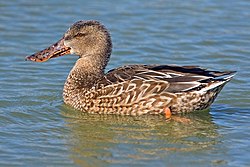Northern shoveler
| Northern Shoveler | |
|---|---|

| |
| Male | |

| |
| Female | |
| Scientific classification | |
| Kingdom: | |
| Phylum: | |
| Class: | |
| Order: | |
| Family: | |
| Genus: | Anas (disputed)
|
| Species: | A. clypeata
|
| Binomial name | |
| Anas clypeata | |

| |
| European distribution. Light green: summer only. Blue: winter only. Dark green: all-year. | |
| Synonyms | |
|
Spatula clypeata (but see text) | |
The Northern Shoveler (Anas clypeata), sometimes known simply as the Shoveler (Template:PronEng), is a common and widespread duck. It breeds in northern areas of Europe and Asia and across most of North America, and is a rare vagrant to Australia. This species was first described by Linnaeus in his Systema naturae in 1758 under its current scientific name[2][verification needed]. Usually placed in Anas like most dabbling ducks, it stands well apart from such species as the Mallard and together with the other shovelers and their relatives forms a "blue-winged" group that may warrant separation as genus Spatula.

The Northern Shoveler is one of the species to which the Agreement on the Conservation of African-Eurasian Migratory Waterbirds (AEWA) applies.[3]
Appearance
This species is unmistakable in the northern hemisphere due to its large spatulate bill. The breeding male has a green head, white breast and chestnut belly and flanks. In flight, pale blue forewing feathers are revealed, separated from the green speculum by a white border. In non-breeding (eclipse) plumage, the drake resembles the female.

The female is light brown, with plumage much like a female Mallard, but easily distinguished by the long broad bill. The female's forewing is grey.
Behaviour
Northern Shovelers feed by dabbling for plant food, often by swinging its bill from side to side and using the bill to strain food from the water. It also eats mollusks and insects in the nesting season.
The nest is a shallow depression on the ground, lined with plant material and down, usually close to water.
This is a fairly quiet species. The male has a clunking call, whereas the female has a Mallard-like quack.
Habitat and range
This is a bird of open wetlands, such as wet grassland or marshes with some emergent vegetation.
In the British Isles, home to more than 20% of the North Western European population, it is best known as a winter visitor, although it is more frequently seen in southern and eastern England, especially around the Ouse Washes, the Humber and the North Kent Marshes, and in much smaller numbers in Scotland and western parts of England. In winter, breeding birds move south, and are replaced by an influx of continental birds from further north.
This dabbling duck is strongly migratory and winters further south than its breeding range. It is not as gregarious as some dabbling ducks outside the breeding season and tends to form only small flocks.
Historic specimens
No living subspecies are accepted today. Fossil bones of a very similar duck have been found in Early Pleistocene deposits at Dursunlu (Turkey). It is unresolved, however, how these birds were related to the Northern Shoveler of today; i.e. whether the differences noted were due to being a related species or paleosubspecies, or attributable to individual variation.[4]
References
- ^ Template:IUCN2006 Database entry includes justification for why this species is of least concern
- ^ Template:La icon Linnaeus, C (1758). Systema naturae per regna tria naturae, secundum classes, ordines, genera, species, cum characteribus, differentiis, synonymis, locis. Tomus I. Editio A. rostri extremo dilatato rotundato, ongue incurvo. decima, reformata. Holmiae. (Laurentii Salvii). p. 124.
A. macula alarum rufa nigra alba..
- ^ "Annex 2: Waterbird species to which the Agreement applies" (PDF). Agreement on the conservation of African-Eurasian migratory Waterbirds (AEWA). AEWA. Retrieved 2008-01-13.
- ^ Template:Fr icon Louchart, Antoine; Mourer-Chauviré, Cécile; Guleç, Erksin; Howell, Francis Clark & White, Tim D. (1998): L'avifaune de Dursunlu, Turquie, Pléistocène inférieur: climat, environnement et biogéographie. C. R. Acad. Sci. Paris IIA 327(5): 341-346.doi:10.1016/S1251-8050(98)80053-0
External links
- RSPB A to Z of UK Birds
- Northern Shoveler Information and Photos at South Dakota Birds and Birding
- Northern Shoveler Information at Cornell Lab of Ornithology
- Northern Shoveler at USGS Patuxent Bird Identification InfoCenter
- Massachusetts Breeding Bird Atlas
- Northern Shoveler videos on the Internet Bird Collection
Gallery
-
Male in Kolkata.
-
Male near Hodal
-
Male & female taking off in Kolkata.
-
resting at Sultanpur National Park





